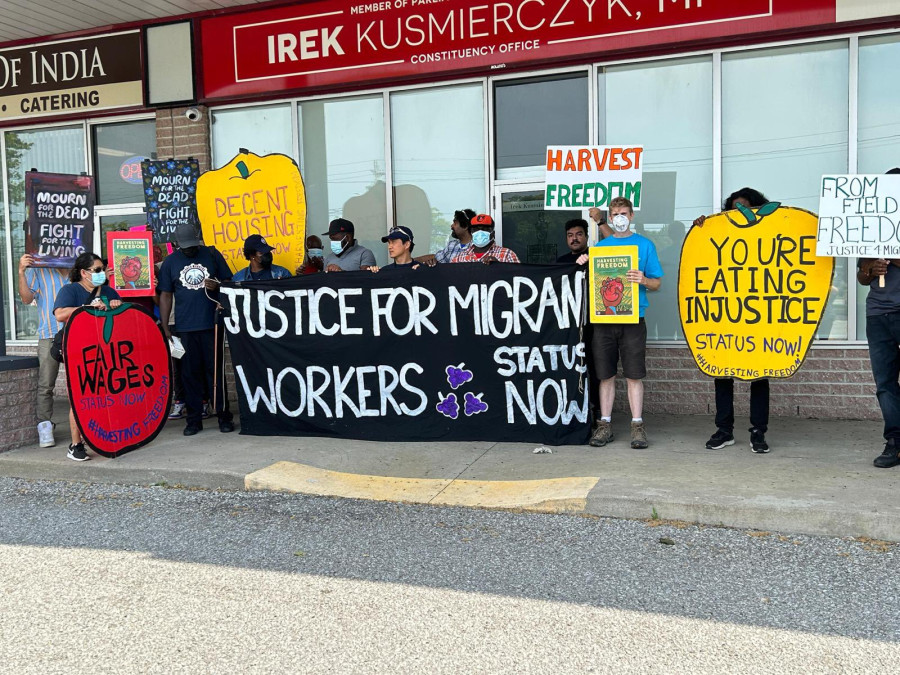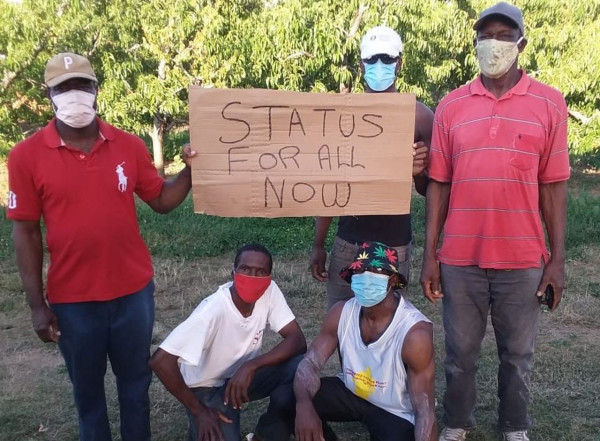A group of temporary foreign workers on a farm near Brantford, Ontario, released an open letter describing living conditions "filled with wastewater overflowing" and bedbug infestations. They speak of enduring shifts that last "14 to 16 hours without adequate breaks," noting that "anyone who complains is sent home the next day."
The letter — obtained exclusively by ByBlacks — highlights the systemic realities that force workers to come to Canada for employment.
"We come here because of economic necessity, not by choice. Yet we are treated like machines, disposed of when no longer useful."
Last month, the Ontario Fruit and Vegetable Growers’ Association painted a different picture of working conditions on farms, issuing a press release announcing the federal government’s finding that employers who hired temporary foreign workers were 94% compliant with employment regulations from April 2022 to March 2023.
This finding by Employment and Social Development Canada stands in stark contrast to reports detailing the agency’s consistent failure to overhaul and improve the Temporary Foreign Worker (TFW) program, leaving intact an exploitative and abusive model that a UN envoy recently likened to modern-day slavery.
Jenna Hennebry, associate director of the International Migration Research Centre, called this latest statistic based on 2,100 completed inspections of TFW employers “falsely high,” noting that their sample was not statistically representative of the total number of farms.
Hennebry highlighted that the press release lacked information on the methodology used and the total number of farms inspected, making it difficult to gauge the scope of the inspections conducted. “This statistic does not share those details, which is how we can accurately assess the margin of error for this percentage.”
The government did not respond to an email asking for clarity about the reports or methodology.
Hennebry says a better statistic would be how many workers make complaints, because the system isn't set up for them to do so despite there being a number they can call in. “They don't feel comfortable doing so because of the power imbalance between them and their employers and their closed work permits,” says Hennebry.
{https://youtu.be/EWbH3N3hYP4}
The Problem With Closed Work Permits
Temporary foreign workers are given a closed work permit to work in Canada, which means they can only work for the employer listed.
If they're fired, they can't legally work anywhere else in Canada, and immediately must return home.
“It's not acceptable to tie a worker to an employer. They do that in Qatar under the kafala system. Why are we doing that in Canada? That needs to stop,” says Hennebry.
This is echoed in the open letter from the farm workers: It’s not fair that we come here on a tied permit.
"We want a better system, not a closed permit. It’s not fair that we sign a contract to work but our employer can decide to send us home at any time. Some of us have already been sent home and new people have been brought up instead."
Of the 28 conditions ESDC looks at for compliance, considerable emphasis is placed on ensuring that employers aren't taking jobs away from Canadian citizens and permanent residents. Before employers can hire temporary foreign workers they have to show in their Labor Market Impact Assessment (LMIA) applications that the worker is filling a role that can't be filled by a Canadian citizen or permanent resident.
Hennebry challenged the narrow scope of these evaluations and compliance criteria. “What are they actually inspecting? What is it compliance to? That matters, because it's not about whether workers have a room in their house that is well-ventilated and safe and not near chemicals, for example…it's actually about compliance to the parameters of the LMIA.”
“One of our bunkhouses had wastewater overflowing and going through the bunkhouse, even into the kitchen. Our employer did nothing about it for several days, and even came into our bunkhouse and yelled at us for causing the problem. He said that we must have poured grease down the drain for this to happen.”
Mexican Government Official Casts Doubt On Reported Compliance Rate
Mexican farm workers make up nearly half of Canada's agricultural temporary foreign workforce annually, most of whom come through the Seasonal Agricultural Worker Program (SAWP); a program that Mexico is often the top contributor.
After reviewing the Ontario Fruit and Vegetable Growers’ Association’s press release highlighting the EDSC’s high compliance rate, a Mexican government official raised concerns that “... we cannot tell that 100% of employers were actually inspected and that they were cleared by the ESDC.”
Though not authorized to discuss the matter publicly, the source pointed out that “the total number of inspections that are referred in the press release…covers all the temporary foreign workers, industries, and employers.” He compared this wide scope to inspections conducted by the Mexican government in the agriculture sector alone. “We have over 2,500 employers that bring workers into Mexico. Not all of them are inspected every year. Not all of them are approved until they meet other requirements.”
The source stated that the ESDC does inspect general TFW regulations; he also clarified that the Mexican government's top priorities remained focused on workers’ pay, housing conditions, and lack of access to health and social services in Ontario.
So why is ESDC focusing on compliance with paperwork and not actual worker conditions?
In 2017, an auditor general’s report showed that of 173 planned ESDC inspections for the TFW program, only 13 were actually conducted, none of which interviewed foreign workers. This was one of several issues raised, which led to a series of recommendations to improve the program that the ESDC committed to implementing.
By 2021, a follow-up report found that despite an additional $16.2 million in funding for agricultural inspections to meet the AG’s recommendations from 2017, 73% of quarantine inspection reports were still found to be problematic, with the AG finding that inspected employers were marked compliant despite conflicting evidence. These systemic problems within the ESDC were magnified over the course of the COVID-19 pandemic, evidenced by the numerous COVID-19 farm outbreaks and worker deaths.
The Mexican government source stated that when he considered the multiple auditor general reports, the UN special rapporteur’s assessment—and most recently, the Jamaican government’s investigations into the firing and repatriation of Jamaican migrant worker whistleblowers—the press release boasting the ESDC’s 94% compliance rate felt “more like a pushback or response” to the increasingly negative press and mounting criticisms of the TFW program.
More details from that open letter give us insight into why ESDC might be doing damage control around this issue.
If we get sick at work, it’s like it doesn’t matter to them. They don’t pay us any sick days and don’t help us if we are sick. They have not given us a health card yet and they have taken away our work permits and employment contracts.
We have been prevented from using the bathroom because it is “company policy” to go only on breaks. But sometimes we are not able to go to the bathroom even on our breaks because we are being moved from field to field.
The drinking water and bathing water at the farm is not safe. Sometimes it smells bad, like wastewater.
It has been very hot to work in the fields. But this employer still makes us work the same long shifts without any extra breaks, no water, no shade or cool areas. They don’t care that we are getting dizzy, or fainting, or ill. They just want us to work.
We feel very bad about the guys who have been sent home because they would like to make money, just like those of us who are here on the farm. The fact that they have been sent home, and replaced with other workers, is really rough. This farm, the boss, they don’t really care about us. They just care about making money. We just have to sit like animals and listen to what they say, and just do it.
Hennebry said that the updated compliance rate doesn't match the considerable evidence indicating gaps in ESDC’s regulatory framework from multiple sources, such as government reports on the TFW program; findings from the 2020 coroner's investigation into COVID-19 deaths of migrant farm workers; or last month’s tribunal ruling that the Worker Safety Insurance Board’s practice of reducing compensation to injured migrant workers was illegal.
“All of these data points are realities that the compliance system is not actually capturing,” Hennebry said, and argued that taken together, they present a more comprehensive picture than the reported 94% compliance rate. “It's not just about what advocates and a handful of workers say…look at those sources of data because they do flag the concerns and changes needed.”
Regulatory Capture In The Agricultural Industry
Regulatory capture refers to a situation where a regulatory body, established to act in the public's interest, is instead swayed and co-opted by the industries or sector it's meant to oversee, leading to decisions that prioritize industry needs over public interests. This concept offers a lens through which to scrutinize the enforcement actions and integrity of agencies like the ESDC.
Despite a stringent penalty structure ranging from warnings to fines of up to $1 million per year and potential bans on hiring TFWs, from January to September of this year ESDC inspectors found only 153 employers non-compliant. Of these, 71 are now eligible to rehire TFWs, with the remaining ineligible employers either facing outstanding penalties or issued bans for a set period of time. The average fine was $15,807, although fines varied drastically.
Hennebry said that high compliance rates are not surprising when you consider the forgiving approach EDSC inspectors take with TFW employers after finding them at fault. “They'd return to that employer and ask, ‘did you do everything? Yes, you did? Okay, you're compliant. Good.’”
Hennebry argued that because inspections tend to lean more towards guidance for employers than enforcement, concerns about regulatory capture could be reasonably raised. “In most cases, it's not even a slap on the wrist or fine. In most cases it's more like ESDC telling employers, ‘let's work with you to get you compliant.’”
While ESDC inspections focus mainly on LMIA criteria at the federal level, there are other regulatory mechanisms at the provincial and municipal levels that are tasked with upholding standards around health, employment, and housing; yet, there's not a clear or uniform system of checks across all these levels. This patchwork approach and bureaucratic landscape is opaque and difficult to navigate, making it easier for departments to shift blame and avoid accountability when problems arise. “The ESDC just assumes that the system below them functions towards some other set of criteria that they're not dealing with,” Hennebry said.
Resisting PR Narratives And Debunking Myths
Chris Ramsaroop of Justicia for Migrant Workers (J4MW) said the OFVGA’s press release reflected an industry-wide attempt at damage control. “They want to meet their needs to address a so-called labour shortage, engaging in a public relations fiasco.” Ramsaroop said that the press release paints a misleading picture of employment equity. “Claims that migrant workers tied to an employer have the same rights as a Canadian are simply not true.”
Hennebry weighed in on the influence of growers' associations in controlling dominant narratives about the TFW program. “Growers associations have had a really key role in the program for a long time. They hold the power and they hold the persuasion with the government. And when there are meetings annually to negotiate the contracts, those organizations are at the table, not migrant worker associations. Not unions, not advocates.”
Narratives and myths about the TFW program are trafficked through the OFVGA’s ‘More than a Migrant Worker’ initiative referenced in their recent press release. Hennebry expressed frustration with the discrepancy between the campaign and what is actually happening on the ground. “I like that it highlights workers for who they are, and their lives, but it's also very romanticized and glossing over all sorts of problems.” Hennebry challenged the authenticity of the campaign, stating it's “not actually representative of the whole program…the reality is, workers are on tied work permits, which is counter international law.”
{https://www.youtube.com/watch?v=54lp0ds951s&t=48s}
Like Ramsaroop, Hennebry agreed the campaign is intended to change public perception while side-stepping accountability. “The campaign is basically saying, 'Look, they're people too!'... but with a paternalistic overlay, trying to get the public to lay off asking for changes.”
The ‘More than a Migrant Worker’ initiative is backed by employer-based groups, Ramsaroop observed. “They've been paying for sponsorship. Many leading publications run the same content.” He critiqued the industry's rosy portrayal of family-owned farms as a settler colonial trope that erases the real experiences of temporary farm workers.
J4MW works to counter these narratives through legal challenges and activism. Recent notable successes include the following:
- This year, the Workplace Safety and Insurance Appeals Tribunal deemed the WSIB's compensation reductions for racialized injured migrant workers unlawful, a landmark ruling that formally recognizes the institutional racism at play.
- In 2022, the Human Rights Tribunal of Ontario determined that the Ontario Provincial Police (OPP) racially profiled 54 migrant farmworkers in 2013. This violation of Ontario’s Human Rights Code led to a potential damages award of $405,000 for the workers.
- By 2023, after the HRTO ruling, the OPP and the Ministry of the Solicitor General were forced to destroy illegally obtained DNA profiles from the 2013 incident, ensuring compliance with Ontario's Human Rights Code.
J4MW collaborates with legal clinics, like the Migrant Worker Clinic at the University of Windsor, to provide support for TFWs. Ramsaroop stressed that resistance to these structural issues are coming from the workers themselves, who have taken to platforms like TikTok to highlight on-farm conditions. “Workers are standing up trying to expose what is happening here on farms.”
The open letter ends with some demands that really are a basic ask for human rights:
We want to have better housing. We want housing where we have enough bedrooms for everyone, enough bathrooms so that everyone has privacy. We want housing where we do not have bedbugs or any other pests. We want clean bunkhouses with functioning appliances - stoves, fridges, microwaves, washers and dryers. We do not want to live in barns with concrete floors. We want to live in proper houses.
We want to be treated with respect at work. We do not want to be yelled at, sworn at, or to get in trouble for using the bathroom. We are not children.
We want the ability to choose where we work and our working conditions. Some of us have been working the night shift for weeks and cannot speak with our families. Some of us want to stay and work at other farms when our contracts end. We want the ability to move to other employers and stay if we want to. It is not fair that we have to work for one employer alone in Canada.
We want to be able to speak up for our rights without getting in trouble and without being sent home. Some of our brothers have already been sent home after we refused to work, when our bunkhouse was flooded with waste water. All workers who have spoken out should not be removed from the program and should not get in trouble in any way.
Sincerely,
A group of workers

 By
By 







